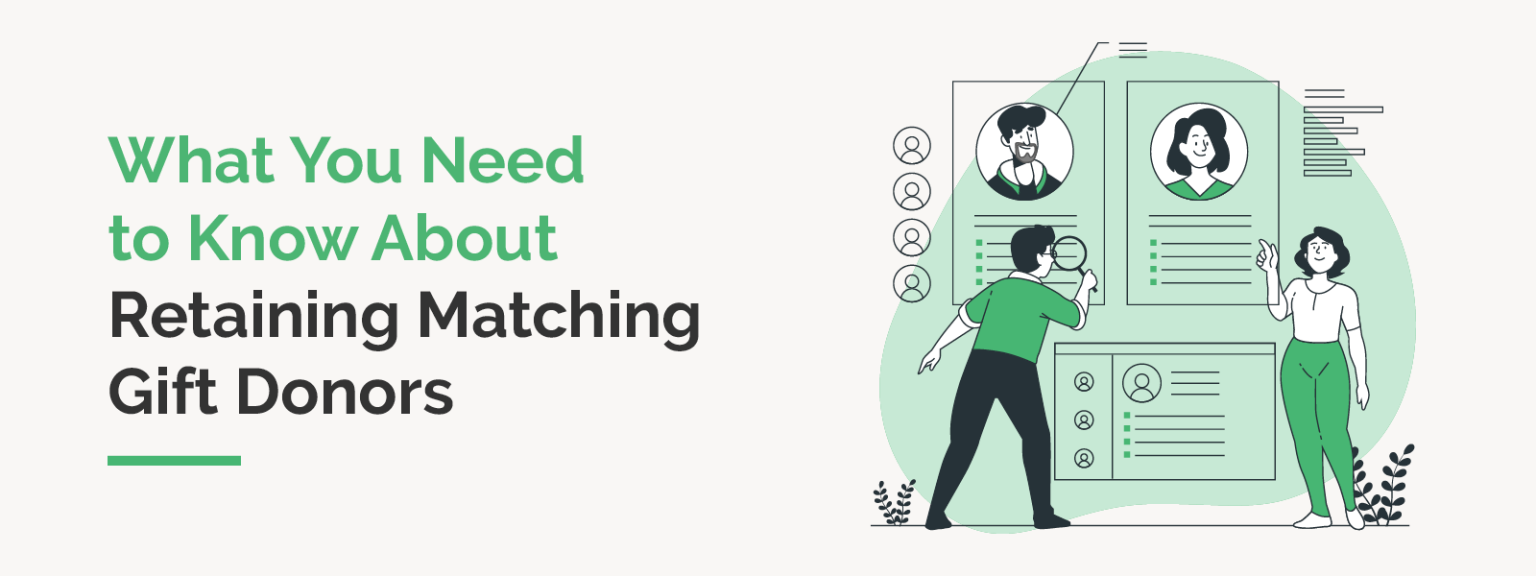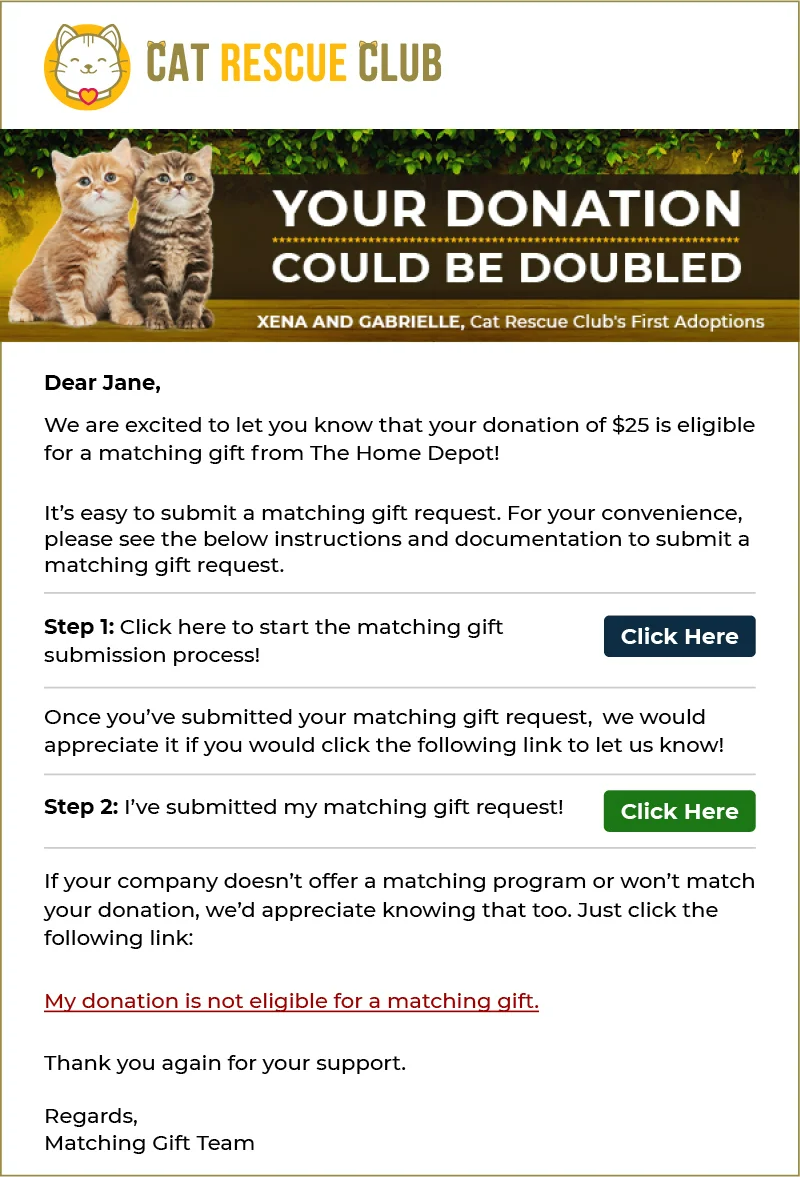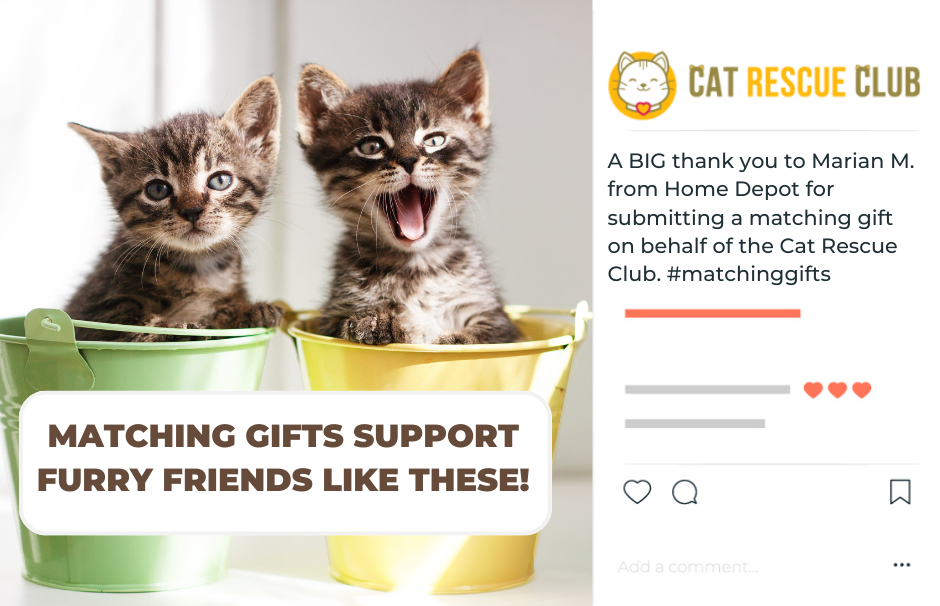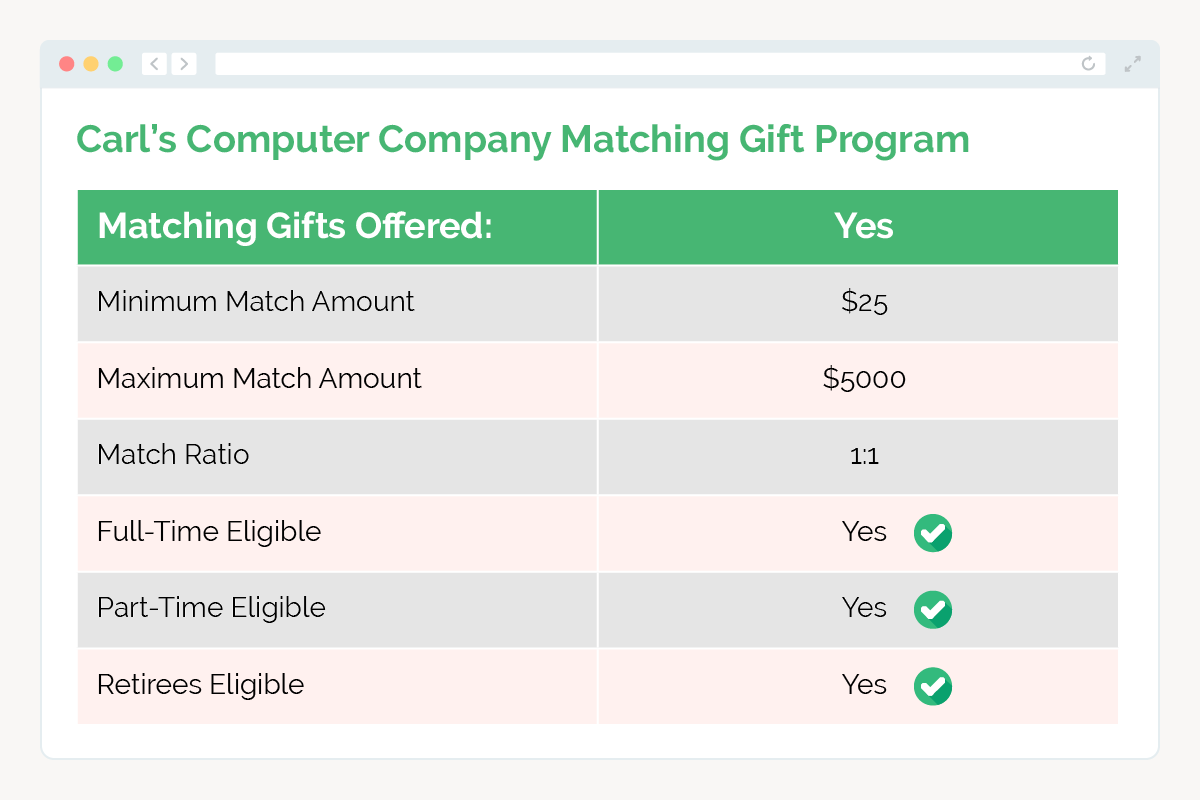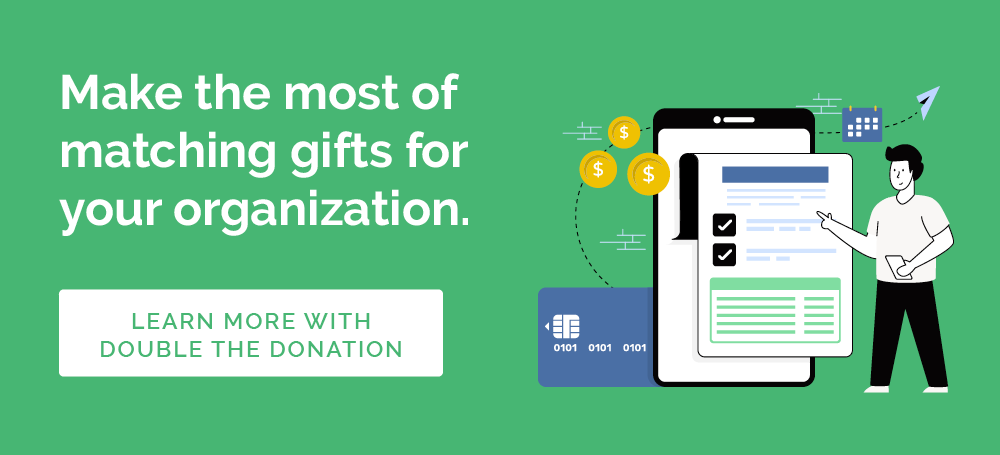What You Need to Know About Retaining Matching Gift Donors
As a nonprofit fundraising professional, you likely understand the importance of maximizing retention among supporters. But do you have a plan in place to go above and beyond, implementing the right strategies for effectively retaining matching gift donors?
After all, this segment has already proven to be some of your most dedicated supporters. Not only have they furthered your cause with their own generous donations, but they’ve gone the extra mile to amplify impact with corporate matching.
Communicating your appreciation for this group is a must. In doing so, you can increase the likelihood that they’ll remain involved with your organization over time.
Read on to explore the following key topics:
- What Are Matching Gift Donors?
- Why Does Matching Gift Retention Matter?
- Key Strategies for Retaining Matching Gift Donors
Ask yourself this: What is your organization doing to thank individuals who submit matching gift requests? How do you ensure these match-eligible supporters will do so the following year and the year after that? Is your staff effectively trained to pursue this opportunity?
Matching gifts are an often overlooked area in fundraising (with more than $4 to $7 billion in available match revenue going unclaimed annually), and the same is true when it comes to matching donor retention.
It’s time to change that! Let’s dive in to discuss effective matching gift donor retention and more.
What Are Matching Gift Donors?

More specifically, they are donors who:
- Work for companies with matching gift programs;
- Qualify for their employers’ matching opportunities;
- Submit matching gift request forms to their employers;
- Result in completed matching gifts being provided to your nonprofit.
These are some of your mission’s most valuable assets, and they’ve shown repeated dedication to your organization. Ultimately, matching gift donors can make a significant impact on a nonprofit’s fundraising efforts, corporate partnerships, and more.
And a large portion of your existing supporters likely qualify for these programs! In fact, an analysis of our matching gift database reports that over 26 million individuals are employed by companies with matching gift programs. That’s a significant opportunity that you don’t want to overlook.
Why Does Matching Gift Retention Matter?
Retaining matching gift donors matters for a lot of the same reasons that retaining traditional donors does. For one thing, it’s significantly easier—and more cost-effective—to obtain repeat funding from existing donors than it is to continuously try to make up revenue from new, one-time supporters.
This is especially true when it comes to matching gifts, as many donors will hear about the opportunity for the first time from your organization. Starting out, most donors will not be aware of their employer’s matching gift programs—even if they qualify to participate. Therefore, you don’t want your efforts used to educate them to only make a one-time impact. When engaging with existing matching gift donors, however, you’ll be able to draw from their knowledge through experience rather than beginning at square one with the basics.
Not to mention, donors love participating in their employers’ matching initiatives. Research even indicates that 84% of individuals are more likely to donate if a match is available, with 1 in 3 stating they’d even increase the size of their gift if so.
Retaining matching gift donors is also a powerful way to build long-term relationships that go beyond the initial transaction, demonstrate impactful financial stewardship efforts, and aid the organization in pursuing its mission more effectively.
Key Strategies for Retaining Matching Gift Donors
Now you should understand the value of retaining matching gift donors over time. But how exactly can you plan to do so?
Here are some of our top-recommended matching gift retention strategies!
1. Make matching easy.
One of the most significant roadblocks to completing matching gifts is a critical knowledge gap surrounding the programs. In other words, eligible donors have no idea that they qualify for corporate matching. And those that have been informed about the programs often remain unaware of how to actually get involved.
In order to drive more matching gifts to completion—the first, second, third times, and beyond—it’s a good idea to make the process quick and easy. With a particularly complicated matching experience, a donor might complete their submission request. But they’re not likely to do so again the following year.
The best way to streamline matching? Employing the right software to do so!
When you leverage Double the Donation’s matching gift tool in your website and fundraising channels, you can pinpoint qualifying donors and maximize potential revenue. It will even provide match-eligible individuals with direct links to company-specific matching forms that can typically be completed in five minutes or less.
Not to mention, new auto-submission capabilities empower qualifying donors to complete their matches right from their favorite organizations’ giving pages. When all it takes is a few clicks of a button to submit a matching gift request, donors will be increasingly likely to do so each time they give.
2. Prioritize two-way communication throughout the process.
You’ve surely heard the phrase, “Communication is key.” When it comes to matching gifts, this is more true than ever!
After all, the process involves a few key stakeholders who each play a critical role in the success of a match—namely, the donor, their employer, and the nonprofit to which they give. By tracking your supporters’ program eligibility and matching gift completions, you can most effectively ensure that everyone is on the same page.
That’s why we recommend asking donors to keep your team up to date on the status of their match requests. In your matching gift emails sent to encourage submissions, offer an easy way for individuals to mark their matches as being requested.
And once their match goes through and your organization receives the corresponding check, your team can properly thank them—closing the loop and confirming with the individual that their match was successful.
The easiest way to do so is with matching gift software! Not only can you easily incorporate an easy “Click here when you’ve submitted your match” button in your communications, but the tool will update responses by donors, enabling your organization to better track matches throughout the gift lifecycle.
3. Track matching gifts by donor.
Keeping track of matching gifts can be challenging without the right tools, but doing so can have a tremendous impact on how you recognize and follow up with matching gift donors. By effectively managing incoming matches, you can provide proper acknowledgment and stewardship to these donors. Ultimately, this helps strengthen your relationships and increase their likelihood of continued support in the future.
Once the matching gift lifecycle is complete, an organization typically receives a matching donation corresponding to the request previously submitted by their donor. Depending on the employer’s disbursement process, the match may show up as a check from the company itself or its CSR management vendor.
However, ensuring you’re able to attribute the match to the individual who requested it is essential for optimizing your matching donor relations. After all, you want to thank the individual donor rather than the employer or the CSR vendor. (Note: You can acknowledge the matching gift company for the donation if you’d like to, though it’s not necessary.)
More than likely, your nonprofit CRM offers the ability to make a note in a donor record or to link together associated donation listings. Make sure to do so in your donor management system and in your matching gift dashboard to maintain a complete picture of your successful matching gifts.
4. Thoroughly demonstrate gratitude.
Matching gifts are a key component of an effective fundraising strategy, and so is thanking the donors who complete the process. Otherwise, you’ll face the possibility of losing valuable supporters. Or, at the very least, they’ll be less likely to submit matching gifts in the future.
A little acknowledgment can go a long way when it comes to retaining your donors—matching gift-specific and otherwise. Personal messages of thanks can be sent using just about any channel but likely include:
- Text message
- Phone calls
- Direct mail
- eCards
With the right automation system (like Double the Donation’s), you can even use customizable templates and brand the outreach to your organization. Plus, your team will save time and effort while ensuring no matching gift donors slip through the cracks.
Regardless of the medium you select, your thank-you note doesn’t have to be long or complicated. All it takes is a few sentences thanking an individual for submitting a matching gift! Not only do donors want to know that their form is being processed, but you’ll also stay fresh on their minds without asking for another donation.
Then, we recommend also employing messages of gratitude upon receiving the completed match. Remember—though the matching gift did not come from the donor’s own wallet, it would not have been possible without their efforts. Oftentimes, these kinds of acknowledgments are sent once the check is actually processed, many months after match forms are initially submitted.
5. Enlist public recognition.
Beyond private efforts of thanksgiving, another way to deepen relationships with matching gift donors involves publicly acknowledging their above-and-beyond support of your cause.
Doing so allows your team to reinforce the impact of matching donors’ actions and stay fresh on their minds by outwardly thanking them.
And going further, it also helps promote these invaluable revenue opportunities to other donors who may not otherwise know about them. So not only is this a great retention strategy, but it can start the matching gift conversation with other supporters, too!
A few recommended ideas include:
- Mentioning matching gift donors by name in a supporter newsletter
- Sharing matching gift donor highlights on your social media pages
- Adding matching gift donors to a (physical or virtual) donor wall
- Acknowledging recent matching gift donors in a fundraising event speech
Keep in mind that if you’d rather not mention all of your matching gift donors publicly by name, you might opt for a running count of matching gifts (or total revenue) received on your organization’s website! You might even call out a few of your company’s top matching gift providers, or the companies that are actively matching gifts to your cause.
6. Highlight amplified giving impact.
As you discuss the importance of matching gifts on your cause—both in public and private communications—it’s a good idea to continuously return the focus to the amplified giving impact made possible by corporate matching.
For example, begin highlighting specific projects or programs that have benefited from matching gift funding. Donors will better understand how the value of their dollars (and continued support through corporate matching participation) is vital to the success of your organization.
Consider this:
“Connie, thank you for your recent matching gift submission. We’ve received a corporate donation from your employer, thus doubling the impact of your initial gift.
Thanks to your contribution and the matching gift you requested on our behalf, we are now able to feed and house TWICE AS MANY furry friends here a the Cat Rescue Club. That’s two times the amount of kittens we’re able to get off the streets this month.”
After all, you know your donors have some sort of connection with your cause. Emphasizing the vitality of matching gifts through tangible mission impact is a great way to deepen your relationships and tug on their heartstrings to drive continuous matching gift involvement.
7. Make a note of matching gift program guidelines.
Each company that offers a matching gift program is able to establish its own eligibility criteria and program guidelines. Most often, this includes a combination of minimum and maximum donation amounts, matching gift ratios, qualifying nonprofit causes and employee types, and submission deadlines.
When it comes to retaining matching gift donors, two of the primary criteria you’ll likely consider are program maximums and submission deadlines. After all, the number of matches an individual can request may be limited by a program maximum. And the submission deadline is typically associated with the resetting of the annual cap. Thus, becoming familiar with this information can ensure your team is able to send targeted messages that adhere to their companies’ requirements.
Here’s an example:
Suzie works for Carl’s Computer Company, which offers a $5,000 match limit annually. She contributes $5,000 to your organization, which is then matched at a 1:1 rate—and puts Suzie at the top of her match cap for the year. You don’t want to bombard Suzie with matching gift appeals she won’t qualify for, so you mark her temporarily ineligible for matching in your software system.
However, you know that Carl’s Computer Company resets its matching program on June 1st, in line with the business’s fiscal year. When Suzie donates to your organization again the following June, you take the opportunity to send a personalized matching gift letter that reminds her of her renewed eligibility through her employer.
Having a solid understanding of your donors’ matching gift guidelines can help your organization tailor its strategy and better appeal to qualifying donors. (Again, a matching gift database tool can be a huge help here!)
8. Calculate year-over-year matching gift rates.
In order to measure your organization’s matching gift success and determine whether you’re effectively retaining matching gift donors over time, tracking and analyzing the right metrics is essential.
To calculate your matching gift donor retention rate, you’ll want to first establish the number of individuals whose gifts resulted in corporate matches during a year-long period. Then, determine the number of individuals whose gifts resulted in corporate matches again the following year. Divide the number of returning matching gift donors by the total number of matching gift donors from the most recent period and multiply the figure by 100.
Here’s an example:
The Cat Rescue Club receives 1,000 matching gifts in year 1. The following year, 400 of those matching gift donors submit matching gift requests again for their most recent gifts.
400 divided by 1,000 equals 0.4, which, multiplied by 100, produces an annual matching gift retention rate of 40%.
From there, you’ll want to continue calculating and tracking this figure over time. The hope is that with the right tips and strategies driving your donor communications, you’ll ultimately see substantial growth in your matching gift retention levels year over year.
If you’re seeing stagnation or a decrease in submitted or completed matching gifts, however, consider revamping your matching gift promotional strategy to expedite growth.
9. Invest in strategic data stewardship.
According to recent studies, it costs an organization $1 to verify a record upon entry, $10 to dedupe and clean data AFTER input, and $100 per bad record if nothing is done. Because identifying matching gift opportunities and maintaining donor retention both begin with having accurate data on your donors, it’s a good idea to kick off your retention strategy by investing in data stewardship.
This can be achieved by concentrating on small changes to processes that your organization may be missing right now. For example…
- Invest in creating a useable policies and procedures manual for data management.
- Run a quarterly NCOA update on your mailing addresses.
- Perform regular donor surveys to collect up-to-date information and communication preferences.
- Strategically plan how you will address data integration across platforms.
- Collect company information each time a donor gives to ensure accurate and up-to-date employment records.
Remember: having accurate information on file helps ensure that your automated marketing will be delivered, personalized, and increasingly impactful to drive more matching gift requests to completion. The cleaner your data, the more positive results you’re likely to see!
10. Use personas to hone your retention message.
Once your organization has established a confident foundation for your donor database, you’ll be able to begin strategic outreach and cultivation around donor retention. Rather than randomly calling people who have donated in the past, we recommend implementing a data-driven outreach plan that centers around the creation of donor personas for your retention and stewardship needs.
The concept of personas originally came from the marketing world as a way to group buyers into key segments of your audience. However, developing a persona to organize your efforts can help clarify the key items that will relate to your audience. Instead of creating mass messaging that doesn’t appeal to anyone, organizations should be crafting communications that speak directly to a specific audience. You can even take it one step further and create personas around new match-eligible donors versus lapsed match-eligible donors.
Wrapping Up
Without generous supporters, your nonprofit would lack the resources necessary to continue working toward its goals. And matching gift donors, in particular, allow you to stretch your funding even further toward your cause.
Thus, make sure these supporters receive the gratitude and recognition they deserve—while also working to simplify the process however you can. By implementing the above-mentioned strategies, you’ll boost your revenue and retain vital support for your cause.
Dive deeper into matching gift strategies for success! Check out the additional recommended resources below:
- 14 Types of Matching Gift Letters Every Nonprofit Should Send. Drive more matching gifts with the recommended matching gift letters and examples in this guide. This includes matching gift appeals, acknowledgments, and thank-you messages!
- Top Matching Gift Practices | Actionable Insights & Examples. Find out some of the ways the largest nonprofits promote matching gift opportunities to their audiences. Plus, see how sample matching gift communications impact retention.
- 8 Ways to Encourage Donors to Submit Employee Matching Gift Requests. Before you can retain matching gift donors, you’ll need to get them to submit their matches in the first place. Read up on eight suggestions for driving matching gifts to completion here.
